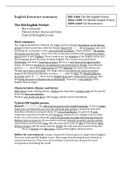English literature summary: 500-1066 The Old English Period
1066-1500 The Middle English Period
1500-1660 The Renaissance
The Old English Period:
- Short summary
- Characteristics (theme and form)
- Typical Old English poems
Short summary:
The original inhabitants of Britain, the Celts, had been largely dependent on the Roman
armies for their protection. After the Roman Empire felt (410) the Germanics, who were
searching for a new place to live, met with little resistance. These invaders - the Angles,
the Saxons and the Jutes - drove the Celts westwards until they had occupied the larger
part of what is now England. These invaders are the founders of the English nation and
their language forms the basis of todays English. The country was converted to
Christianity and lived a long time in peace. But hen, a new wave of foreign invaders
began; the famous monastery of Lindisfarne was destroyed by Vikings (Scandinavian
pirates) (793). Soon they came to stay and The Danelaw, the area controlled by the
Vikings, grew faster and faster. The Anglo-Saxon king Alfred the Great prevented
England becoming Scandinavian territory (871). After he died, the Danish influence
increased again. In 1042 there was an English king again; Edward the Confessor, who
had spent the years of Danish rules in Normandy. Therefore, a new chapter of the
English History began.
Characteristics (theme and form):
Alliteration (same starting letters), rhythm was important; complex rules for the poetry
about the lines and syllables.
Themes: war, death and glory. About men; woman weren’t mentioned.
Typical Old English poems:
Beowulf (6th century): the oldest known poem in the English language. It was an Anglo-
Saxon epic, of which there are very few left from that period; a long clear story that
describes adventures and good deeds. It’s set in Scandinavia, in a period of lords
(expected to pay their retainers) and retainers (expected to be willing to die for their
lords). It is a story about Beowulf, a hero of enormous strength who acquires fame by
fighting various monsters. He succeeds to kill both Grendel (monster) and his mother,
returns home and becomes king, after his uncle died. Later he dies of his injuries after
killing a dragon with his trusty warrior, Wiglaf; the only man who stayed to help him.
- There is rhythm and alliteration. (typical Old English characteristics)
Riddles for entertainment: A major, impressive literary genre in Anglo-Saxon England.
There are Latin and Old English verses. They range from theological and scholarly to
comical and obscene. They were all an attempt to provide new perspectives and
viewpoints in describing the world.
, The Middle English Period:
- Short summary
- Characteristics (theme and form)
- Typical Middle English poems + poets
Short summary:
After Edward ‘the Confessor’ died in 1066 and both Harold Godwinson and Duke
William of Normandy (seems had been named as successor) wanted to become the new
king. When Harold was crowned, William started the Battle of Hastings. Harold got killed
William ‘the Conqueror’ became king and changed a lot; Normans had the most
important positions in the Kingdom and Norman French became the new language used
in the higher circles. By the time that English was the one national language again (14th
century), it had already taken over lots of French words. Poetic form also changed;
Characteristics (theme and form):
the alliterative line was replaced by the French type with end-rhyme and fixed syllable
patterns, the themes were now love, courage and chivalry, women were given an
important place in the literature and the heroic ideal was know a knight who combined
strength with gentle manners and reverence for women, his own lady in particular. The
most popular genres were the ballads, and the romances (love and adventure).
Typical Middle English poems + poets:
Geoffrey Chaucer (Canterbury Tales): Chaucer - often called the Father of English
Literature - became a trusted servant of the king. He was several times sent on
diplomatic missions to France and Italy. His masterpiece is The Canterbury Tales; A
collection of stories, told by thirty pilgrims (including himself), who travelled together
from London to Canterbury. This wasn’t only for entertainment, it was also a ‘story-
telling contest’; the winner gets a free meal when back in London. There are also
descriptions of the tellers themselves. Together they form a unique description of a
nation; from a host and a knight, to a weaver and a cook, they all tell their story. He also
grabs the opportunity to criticize for instance the church, the clerks and the hypocrisy
and greed of people in general. The tales offer a fascinating insight into English life
during the late 14th century. The Knight: the personification of courtesy, a description of
how good a knight is. The wife of Bath’s Tale: She is really experienced because of her
five marriages. She tells her man what woman really want; domination over their
husbands. And also she taught him that the inside is more important than the outside.
Ballads: It’s a genre that developed in England in the Early Middle ages (most popular
between 1200 and 1500). They were meant to be sung and handed over for generations.
But they weren’t only for amusement, they were also used to communicate news
(real/fictious) and to express opinions. Characteristics: central story line. Simple story
and language. Themes; betrayal, lost love, revenge and death. Supernatural and
superstition. Repetition. Jumps in the flow of the narrative. Not detailed (.catchy).
Journalistic style; unemotional. Four-line stanzas: ABCB. Set number of syllables; lines
1&3: 8, lines 2&4: 6. Iambic pattern. Often a ballad starts at a climax, building up the
tension by a series of questions and answers, revealing how the event came to pass.






